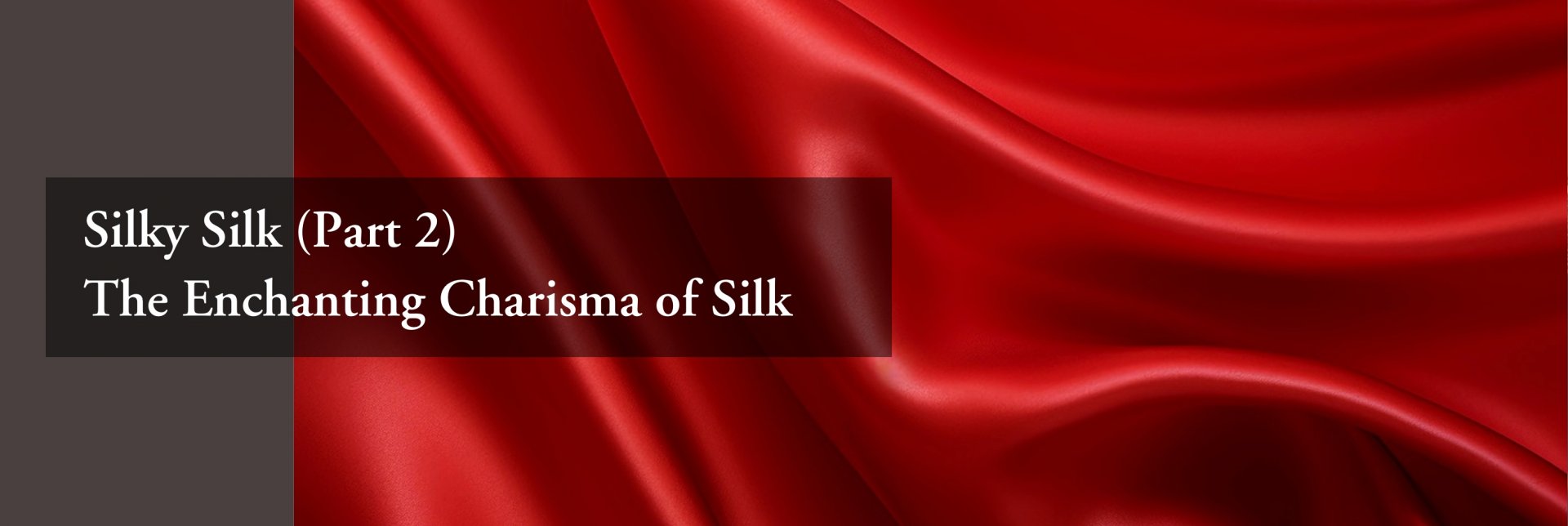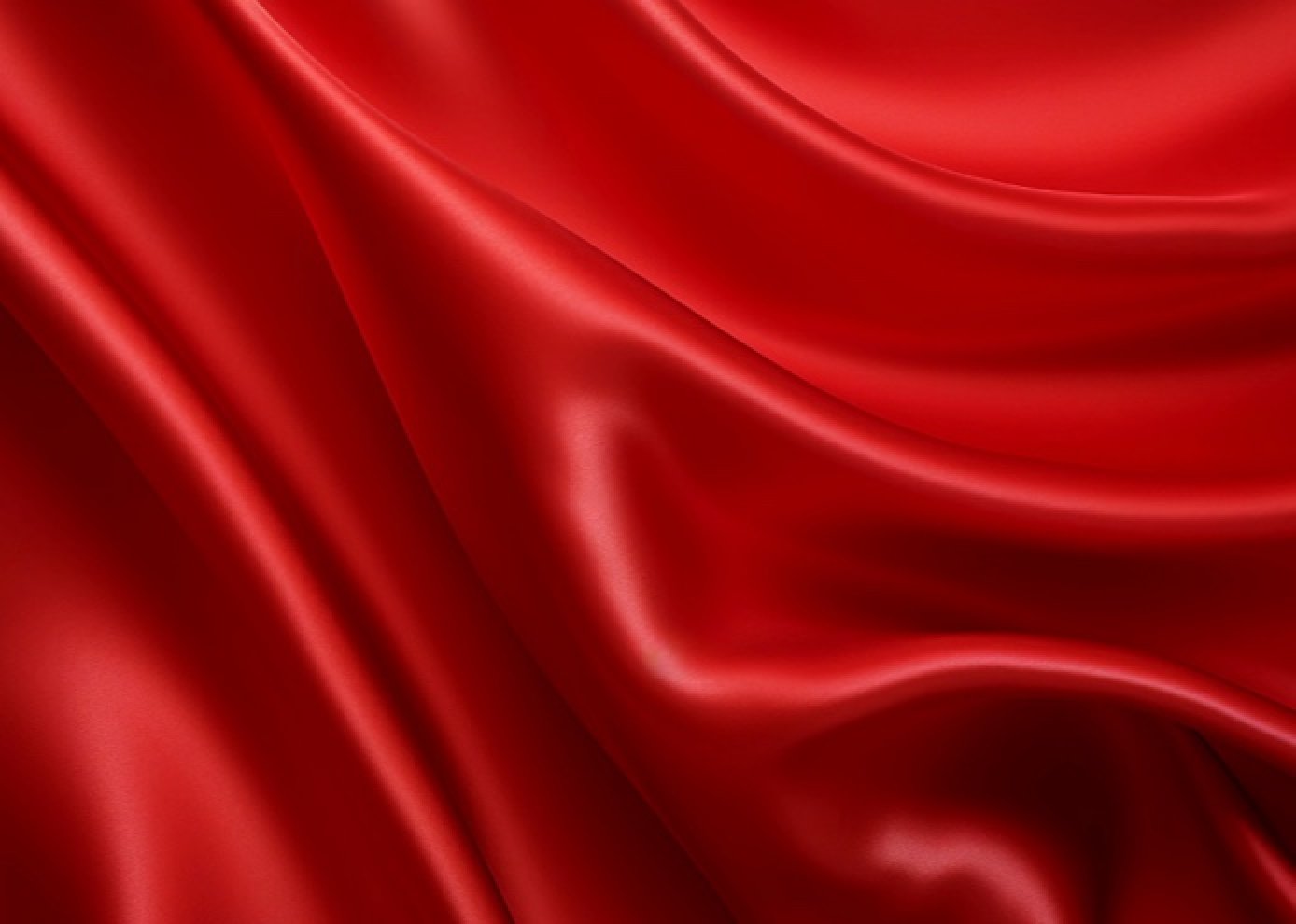Silky Silk (Part 2):
The Enchanting Charisma of Silk
Silk, the epitome of luxury textile, is spun by silkworms to create their intricate cocoons. Its exquisite quality lies in the smoothness of the fibers and the delicate, lustrous appearance it imparts. As a natural fiber, silk is unparalleled in its beauty and elegance.
Silk's allure is attributed to its inherent luminosity. When silkworms secrete their silk, the liquid filaments are extruded through spinnerets in a structured manner, forming layers of coagulated fibroin. These layers reflect and refract light, producing a soft, pearlescent sheen that is far from the harsh glare of synthetic fibers. Silk's gentle radiance creates an understated elegance and evokes a sense of nobility. Just as the poet Bai Juyi (白居易,772-846) wrote in Liao Silk (《繚綾》) "Vibrant colors hidden in unique patterns, appearing different from every angle (異彩奇文相隱映,轉側看花花不定)."

Silk possesses exceptional moisture absorption and wicking properties, making it ideal for garments that maintain the skin's hydration level. During hot summer months, silk clothing allows for rapid evaporation of sweat and heat, ensuring a cool and comfortable sensation. Its natural breathability makes it a preferred choice for intimate apparel, sleepwear, bed sheets, lightweight tops, blouses, and flowing skirts. Additionally, silk provides excellent insulation properties. The fiber's porous structure contains numerous microscopic voids within its filaments, accounting for approximately 40% of the fabric's volume. These air pockets impede heat transfer, resulting in superior thermal insulation. Therefore, draping a thin silk scarf around the neck during winter offers warmth and comfort. Silk bedding, with its multitude of interlocking fibers and inherent porosity, provides added insulation and helps retain body heat. Furthermore, silk's lightweight, supple nature, combined with its excellent drape and resilience, enhances its suitability for creating garments that effortlessly complement the body's curves.


Silk is predominantly composed of proteins, specifically sericin and fibroin. These proteins, derived from the silkworm's silk gland, impart it with the unique characteristics. The smooth and soft texture of silk fabric, combined with its low friction coefficient, ensures a luxurious tactile experience. Silk's biocompatibility with human skin arises from its amino acid composition, which closely resembles that of human skin. This similarity allows silk to seamlessly integrate with the body, offering exceptional comfort and softness. Such a close affinity to the skin is challenging to replicate with synthetic fibers.

Silk's inherent strength is a testament to its resistance to pilling and wear. Comprised of long and continuous filaments measuring up to 1500 meters in length, silk exhibits excellent tensile strength, flexibility, and resilience. These properties contribute to silk's superior drape and flowing characteristics, enabling garments to effortlessly fall and move gracefully. Moreover, longer silk fibers are less prone to breakage and pilling compared to shorter fibers found in synthetic and other natural fibers. Silk's inherent softness and elasticity allow it to maintain its shape and resist deformation. This exceptional dimensional stability is especially important for garments like qipaos, wedding gowns, and other form-fitting attire.
Silk boasts excellent dyeability, as it readily accepts a wide range of dyeing stuff and exhibits minimal temperature sensitivity. Due to the silk fiber's slight cationic nature, it has a high affinity for dyes, resulting in vibrant colors. Historically, natural dyes derived from plants, including flowers, leaves, stems, barks, and minerals, were used to create a rich palette of hues. The art of silk dyeing was highly developed, with the Ming Dynasty's The Exploitation of the Works of Nature (《天工開物》) documenting twenty-six different dyeing techniques. And Bai Juyi’s poem Liao Silk (〈繚綾〉) also described the thrivingness: “People waving according to the pattern from the imperial palace for the nobility…then dyeing the gorgeous shades like the Spring water of Jiangnan (天上取樣人間織……染作江南春水色).” This mastery of dyeing produced silk fabrics that maintained their brilliance and richness over time. In contrast, synthetic fibers often struggle to achieve the same level of color fidelity or consistent color distribution.

Silk also possesses remarkable sound absorption, dust retention, and heat resistance properties. The fabric's high porosity, characterized by numerous pores and even hollow fibers, contributes to its sound-absorbing capabilities and air permeability. Thus, silk is not only suitable for apparel but also finds applications in interior decorations such as silk carpets, tapestries, curtains, and wall coverings. “The woven blanket was laid as the carpet in the palace (織作披香殿上毯).” Using silk as a material in room decor not only helps maintain a dust-free environment but also contributes to a serene ambiance. Silk's moisture-absorbing and moisture-retaining properties, combined with its ability to regulate temperature and humidity, make it an ideal choice for creating a comfortable indoor environment. Furthermore, silk fibers exhibit excellent heat resistance, allowing them to withstand higher temperatures without losing their integrity. Compared to highly flammable materials like cotton or synthetic fibers, silk is considered moderately flame-resistant, making it a safer option for various applications.
In textile studies today, various types of yarn are developed to mimic the shine of silk, such as ultrafine fibers, synthetic filament yarns, and composite fibers. By altering the fiber cross-section and utilizing surface etching, the fibers are made to have uneven and relaxed structures, resulting in a thinner and lighter texture. The aim is to achieve a soft texture, gentle luster, and good drape performance similar to natural silk. However, how does silk respond to the challenges posed by artificial fibers?
In recent textile research, scientists have developed innovative methods to dissolve silk cocoons without compromising the fiber's molecular structure. This process allows for the extraction of fibers with enhanced hardness, double that of conventional silk. The new silk fibers hold immense potential for diverse applications. Their biocompatibility makes them suitable for medical purposes, while the addition of carbon nanotube layers enables conductivity, facilitating their use in advanced sensing devices. Bedsheets made from this silk can be utilized in healthcare settings, monitoring pressure to help prevent bedsores and alert caregivers when patients remain in the same position for too long. These advancements are on the verge of practical implementation.
These advancements in silk production can be achieved through techniques such as three-dimensional printing systems and the use of reconstructed materials derived from silk solutions. The versatility of the new manufacturing process allows for traditional techniques as well as the production of non-woven fabrics, enabling commercial-scale production. The unique properties of silk fibers can be fully retained, while additional coatings can be applied to improve specific attributes such as wrinkle resistance, colorfastness, or abrasion resistance. Furthermore, employing more environmentally friendly dyeing methods during silk production helps reduce the environmental impact associated with the silk industry.
As silk remains an integral part of Chinese culture, it continues to evolve with changing market demands and technological advancements. While preserving its distinctive qualities, silk embraces innovation, seamlessly merging tradition and progress. Upholding the spirit of Chinese culture, scientists and visionaries work tirelessly to enhance and preserve silk's delicate charms. This collaboration ensures that silk meets the evolving needs of consumers while embodying the legacy of the splendid Chinese culture, creating a harmonious synergy between tradition and technological progress. It is really the spirit of Dragon Vein!
Major Reference
1、朱新予:《中國絲綢史》,北京:紡織工業出版社,1997年。
2、黃能馥,陳娟娟:《中國絲綢科技藝術七千年》 ,北京:中國紡織出版社,2002年。
3、國家圖書館:《絲綢中的記憶》,北京:國家圖書館出版社,2013年。
All articles/videos are prohibited from reproducing without the permission of the copyright holder.




Welcome to leave a message:
Please Sign In/Sign Up as a member and leave a message